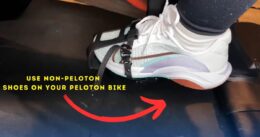Sure, Peloton shoes are great, but what if you want to rock your favorite kicks? We’re diving into the nitty-gritty of using non-Peloton shoes on your Peloton bike.
Indoor cycling on a Peloton bike is a game-changer, but here’s the catch: your footwear matters. Unlike a casual pedal around the neighborhood, Peloton uses a specific cleat system that demands compatible shoes for the ultimate ride. The reason? Your feet need to be securely fastened to the pedals for peak power and stability. Peloton shoes are specially designed for this, offering a snug fit, efficient power transfer, and comfort for those long rides.
Now, the big question: Can you use your shoes? Sure, Peloton shoes are great, but what if you want to rock your favorite kicks? We’re diving into the nitty-gritty of using non-Peloton shoes on your Peloton bike. Will it affect your ride? What’s the deal with cleats? Get ready for the lowdown on making your Peloton experience uniquely yours, one pedal stroke at a time.
Understanding How Peloton Pedals and Cleats Work
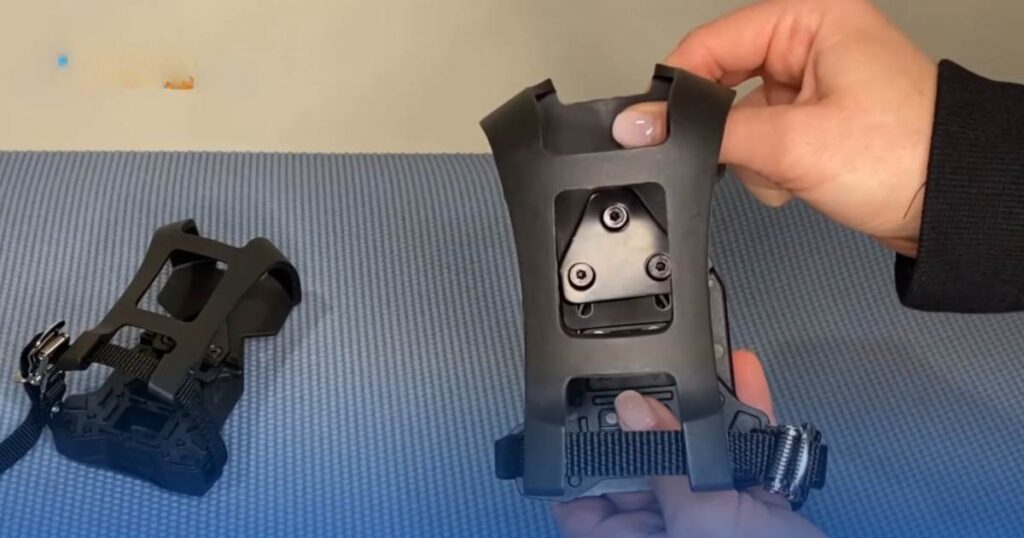
Peloton’s Cleat System Unveiled
Let’s dive into the magic that makes your Peloton ride a seamless experience. The cleat system on your Peloton bike is like a secret handshake between your shoes and the pedals. These little gadgets, attached to the soles of your cycling shoes, ensure a snug and efficient connection, making every pedal stroke count. Peloton’s clever design aims for stability and power transfer, giving you the best ride possible.
Picture it like this: you slip your feet into cycling shoes with these cleats attached, and with a satisfying click, you’re securely locked into the Peloton pedals. This not only enhances your pedal efficiency but also keeps your feet in the correct position, reducing any chances of discomfort or awkward movements during your workout.
Types of Cleats That Play Well with Peloton
- SPD Cleats: Simple and Universal
- Imagine SPD cleats as the friendly, easygoing pals of the Peloton world. These cleats, following the Shimano Pedaling Dynamics, use a straightforward two-bolt system. What’s great is that SPD cleats are like the all-inclusive pass to the Peloton party – they work well with various cycling shoes, making your shoe selection a breeze and opting for non-Peloton shoes with SPD cleats. No problem; they’ll happily join the Peloton dance.
- Delta Cleats: Elegant and Stable
- Now, think of Delta cleats as sophisticated companions, adding a touch of elegance to yours ride. Also known as Look Delta cleats, they use a three-bolt setup, providing extra stability. While they’re often associated with road cycling shoes, Peloton’s open-mindedness means you can bring your style to the pedals. The three-bolt design ensures a secure connection, offering a different feel compared to SPD cleats. Understanding these cleat options empowers you to choose the footwear that not only fits your Peloton but also suits your riding style. It’s like finding the perfect dance partner for your Peloton party – comfortable, compatible, and ready to move!
Finding the Right Shoes: Peloton vs. Your Favorites
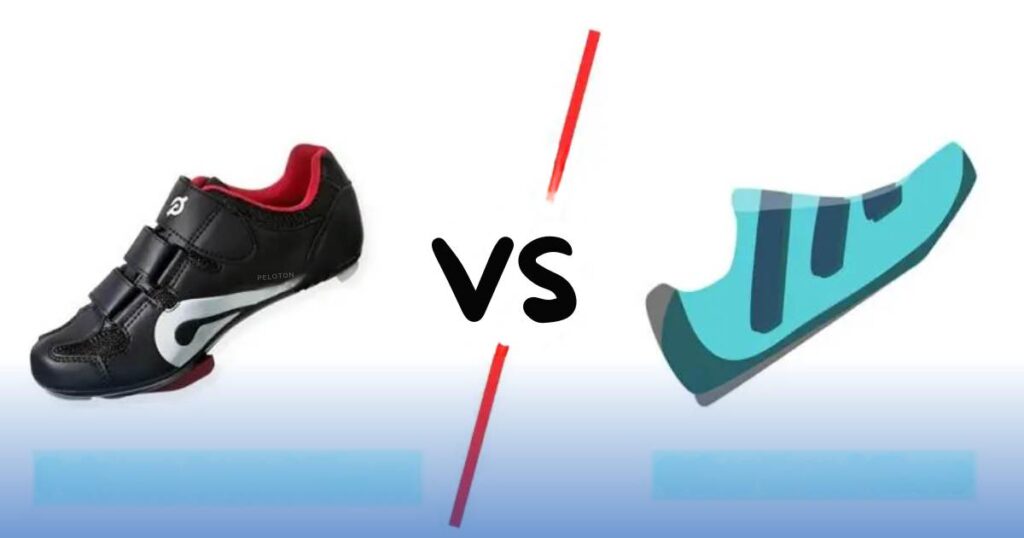
Choosing the right shoes for your Peloton journey involves a comparison between Peloton’s specialized footwear and your trusty athletic kicks. Peloton shoes are custom-made for the bike, offering features like good ventilation, a stiff sole for power, and secure closure systems. These shoes are designed to enhance your indoor cycling experience, providing a balance of performance and comfort.
Understanding Peloton Shoes
Peloton shoes are all about the indoor cycling game. They keep your feet cool, thanks to intelligent ventilation, and provide a solid base with a stiff sole for those intense rides. Whether you prefer traditional laces or the convenience of BOA closures, Peloton shoes are crafted with your cycling needs in mind.
Exploring Your Options
On the flip side, opting for your favorite non-Peloton shoes means you can bring your personal touch to the game. You may have a pair of trusted cycling shoes or cross-trainers that you love. The flexibility to choose based on your style and comfort is a significant perk here.
Pros and Cons
Peloton shoes come with their advantages – optimized design, support, and a tailored feel for the bike. On the other hand, non-Peloton shoes offer familiarity and a broader range of choices. However, your preferred shoes might lack some of the specialized features Peloton shoes have, potentially affecting your ride experience.
Getting the Fit Right: Cleats and Comfort
Now, let’s talk about the nitty-gritty of making sure your chosen shoes fit snugly and comfortably on your Peloton bike.
Cleat Attachment
When using non-Peloton shoes, attaching cleats securely is a game-changer. Align them correctly on the shoe sole, tighten them up, and you’re good to go. This ensures a stable connection with the pedals, preventing any unexpected slips during your rides.
Comfort and Performance Adjustments
It’s not just about attaching cleats – finding the correct position for them is key. Experiment with positions that match your natural foot alignment. Also, play around with pedal tension settings to discover the sweet spot for a comfortable and efficient pedal stroke. This personalized adjustment minimizes the risk of discomfort during your rides.
In the end, whether you go for Peloton shoes or stick to your favorites, ensuring a proper fit and comfort is the key to an enjoyable indoor cycling experience. So, grab your preferred pair, strap in, and pedal away with confidence!
Choosing the Right Shoes for Your Peloton Bike
Finding the Perfect Fit for Comfortable Rides
When it comes to selecting shoes for your Peloton bike, comfort is key. Imagine slipping into a pair that feels like a natural extension of your feet, supporting you through every pedal stroke. The right fit not only ensures a comfortable ride but also maximizes your performance. Look for shoes with adjustable features like Velcro straps or boa dials, allowing you to customize the fit according to your unique foot shape. A snug and secure fit prevents unnecessary movement, keeping you focused on your workout.
Features to Boost Your Ride
Indoor cycling demands specific features from your shoes. The first consideration is compatibility with the Peloton pedal system. Ensure the shoes support SPD or Delta cleats, aligning seamlessly with your bike. A stiff sole is your secret weapon for efficient power transfer – each pedal stroke translating to a smoother ride. Prioritize ventilation to keep your feet cool and dry, especially during longer sessions. Shoes with breathable materials or perforations strike the right balance, enhancing your overall comfort.
Top Picks from Trusted Brands
Navigating through the sea of options can be overwhelming. To simplify your search, turn to well-established brands known for their quality and performance. Shimano, SIDI, Giro, and Fizik have earned their stripes in the cycling world. Models like the Shimano RP3, SIDI Genius 7, Giro Techne, and Fizik R5 have garnered praise for their durability and comfort. Real-world reviews and recommendations from fellow Peloton enthusiasts offer valuable insights, guiding you toward the perfect pair that aligns with both your preferences and the demands of your Peloton workouts.
In the world of Peloton, your choice of shoes can significantly impact your overall experience. By prioritizing comfort, key features, and reputable brands, you’re not just choosing shoes – you’re investing in rides that are comfortable, efficient, and tailored to your unique needs. Happy cycling!
Selecting the Right Cleats
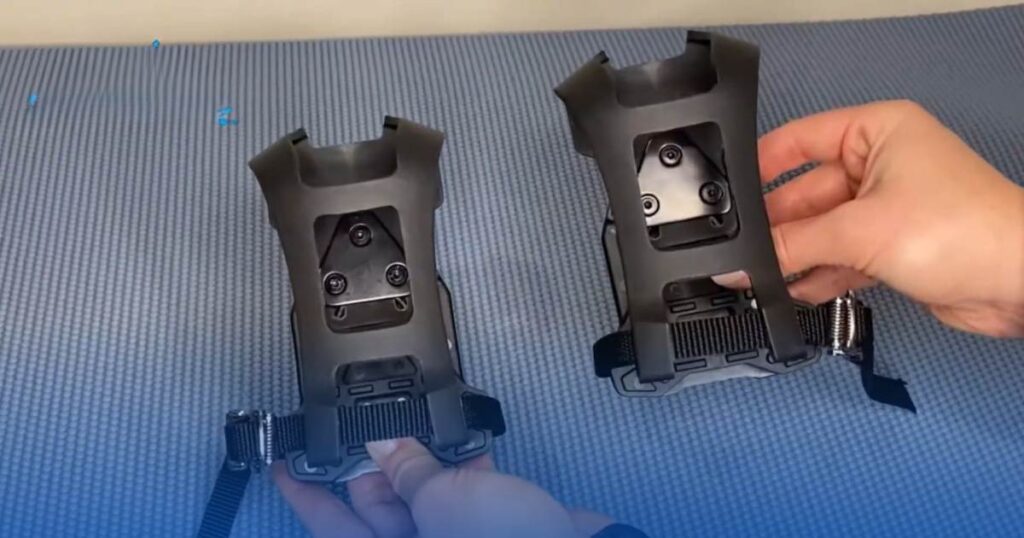
Compatible Cleats for Peloton
When it comes to using non-Peloton shoes on your Peloton bike, selecting the right cleats is paramount. Two main types of cleats that are compatible with Peloton pedals are SPD cleats and Delta cleats.
SPD Cleats: Pros and Cons
SPD, or Shimano Pedaling Dynamics, cleats are a widely recognized and versatile option for indoor cycling. One of the notable advantages of SPD cleats is their smaller size and dual-sided design, making it easier to engage with the pedal. This design allows for a quick and effortless connection, especially beneficial for those new to cycling or frequent start-stop scenarios during a workout.
However, the compact size of SPD cleats may lead to a slightly smaller contact area with the pedal compared to Delta cleats. Some riders find that this can impact the feeling of stability, especially during intense or prolonged cycling sessions. Despite this, many users appreciate the convenience and ease of use that SPD cleats offer.
Delta Cleats: Pros and Cons
Delta cleats, also known as Look Delta or three-bolt cleats, are another option compatible with Peloton pedals. These cleats are characterized by a larger surface area, providing a more substantial contact point with the pedal. This design enhances stability and power transfer, making Delta cleats a preferred choice for some experienced cyclists.
The larger size of Delta cleats may, however, make clipping in and out a bit less intuitive, especially for beginners. Additionally, Delta cleats often require precise alignment for optimal engagement, which might take some time to master. Despite these considerations, many riders appreciate the enhanced support and efficiency offered by Delta cleats, particularly during longer rides.
Installation and Adjustment Tips
Aligning Cleats Properly
Regardless of the cleat type chosen, proper alignment is crucial for a practical and comfortable cycling experience. Misaligned cleats can lead to discomfort, reduced power transfer, and even potential injuries. When installing cleats on non-Peloton shoes, take the time to align them symmetrically, considering factors such as foot position and natural pedal stroke. Experimenting with minor adjustments can help tailor the alignment to your individual biomechanics and riding style.
Checking Tension and Release Settings
Once the cleats are aligned, it’s essential to check and adjust the tension and release settings on your Peloton pedals. Stress refers to the force required to clip in and out of the pedals. Beginners may prefer lower pressure for more effortless engagement and disengagement. At the same time, experienced riders may opt for higher tension for a more secure connection. Regularly inspect and adjust these settings based on your comfort level and evolving skill as a cyclist. Proper tension and release settings contribute to a safer and more enjoyable ride, regardless of whether you are using Peloton or non-Peloton shoes.
Tailor Your Peloton Ride to Your Style
Make your Peloton journey uniquely yours by choosing non-Peloton shoes that match your personal preferences. Just like picking your favorite workout playlist, selecting the right shoes adds a personalized touch to your indoor cycling experience. Whether you’re into a sleek design, extra cushioning, or specific support features, non-Peloton shoes give you the freedom to ride in style while keeping your feet happy.
Picture this: slipping into your preferred athletic shoes designed to cater to your individual needs. It’s like finding the perfect workout buddy – reliable, comfortable, and always in sync with your moves. With non-Peloton shoes, you’re not just riding; you’re crafting a fitness experience that aligns seamlessly with your unique taste and requirements.
Maximize Your Collection, Minimize the Cost
Why limit your options when you can maximize your existing shoe collection? If you already own quality athletic shoes suitable for indoor cycling, embrace the freedom to use them on your Peloton bike. It’s not just about saving money; it’s about making the most of what you already have. Imagine effortlessly transitioning from a brisk outdoor ride to an energetic Peloton session without the need for an extra shoe investment.
This approach isn’t just about being savvy with your budget; it’s an intelligent way to incorporate variety into your fitness routine. Your Peloton bike becomes a versatile platform that adapts to your diverse shoe collection, allowing you to explore different workouts without the hassle of switching shoes. It’s a win-win situation – more workout options without straining your wallet.
Keep Your Finances Fit
When it comes to cost, non-Peloton shoes offer a wallet-friendly alternative without skimping on quality. Peloton-branded shoes may come with a premium price tag. Still, non-Peloton options provide excellent performance without breaking the bank. By choosing shoes that fit your budget, you’re not just investing in footwear; you’re investing in a sustainable fitness routine.
Think of it as a smart financial move – freeing up funds for other fitness essentials or rewarding yourself with small treats along your health and wellness journey. With non-Peloton shoes, you’re not compromising; you’re making a sound investment in your fitness future while keeping your finances in excellent shape.
Enhancing Your Peloton Experience with Different Shoes
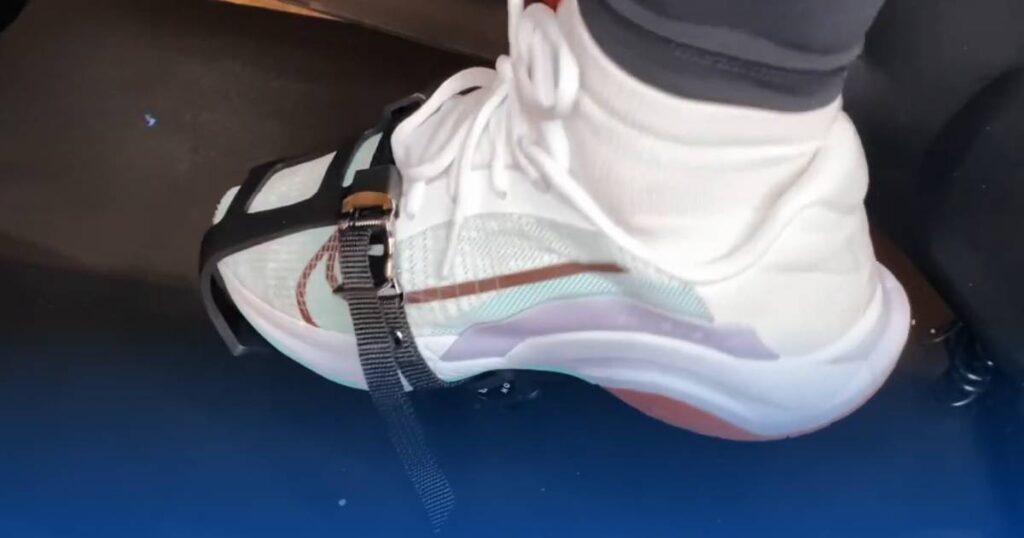
Keeping an Eye on Your Ride Stats
When you’re thinking about using your favorite sneakers instead of Peloton-branded shoes, it’s essential to consider how this choice might affect the ride metrics you love tracking. Peloton shoes are designed to seamlessly communicate with the bike, ensuring accurate readings of your cadence, resistance, and power output. Using non-Peloton shoes might tweak these numbers a bit, so it’s wise to pay attention and make minor adjustments as needed. Remember, the goal is to keep enjoying your workouts while staying aware of any changes in the data you rely on for your fitness journey.
Protecting Your Bike Investment
Your Peloton bike is a significant investment, and part of what keeps it running smoothly is the warranty that comes with it. Before swapping out Peloton shoes for your own, check the fine print on your security. Some contracts might have clauses about using only Peloton-approved accessories to maintain coverage. It’s like an insurance policy for your bike, and being mindful of these details ensures you can ride confidently without compromising the protection that comes with your warranty. If you need more clarification, a quick call to Peloton’s customer support can provide the clarity you need to ride worry-free.
Taking Care of Your Bike’s Feet
Think of your Peloton pedals and cleats as the feet of your bike. Just like you’d take care of your own feet, a bit of TLC goes a long way. When you’re using non-Peloton shoes, it’s essential to stay on top of maintenance. Regularly check the condition of your cleats and ensure they’re securely attached to your shoes. Also, give the pedal system a clean and a bit of lubrication. This simple upkeep ensures that your bike’s “feet” stay happy, allowing you to pedal away without worrying about long-term wear and tear.
In the end, using your shoes on your Peloton bike is about finding a balance between what works for you and keeping things in top-notch condition. By staying mindful of your ride stats, warranty coverage, and bike maintenance, you can enjoy a personalized Peloton experience that suits both your style and your bike’s well-being.
Conclusion
Let’s sum it up! We’ve covered a lot about using non-Peloton shoes on your Peloton bike. The key takeaway is that compatibility is the name of the game. Your cleats need to sync up with the Peloton pedals, and we’ve explored the nitty-gritty of SPD and Delta cleats to help you make the right choice. We’ve also compared Peloton shoes with other options, giving you a clear picture of what works best for you.

